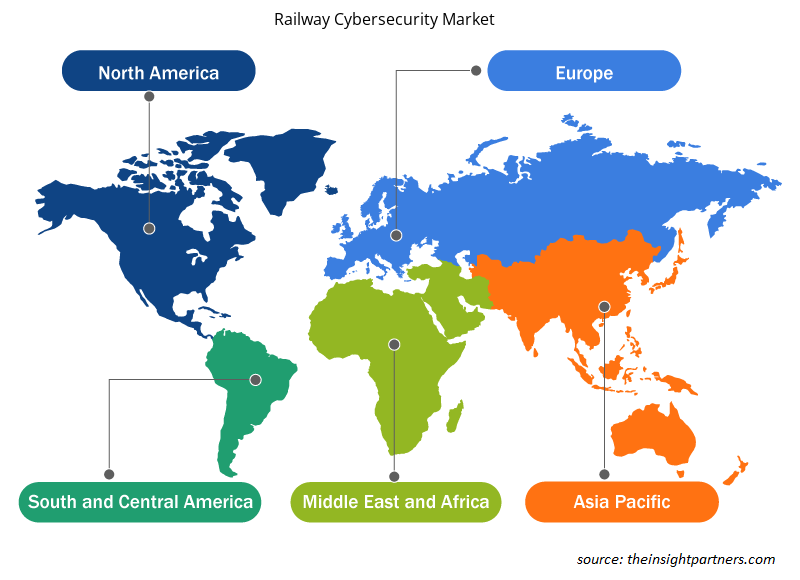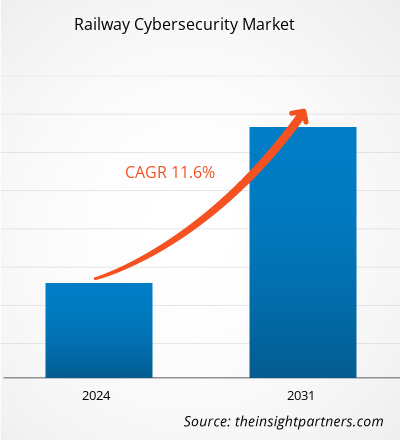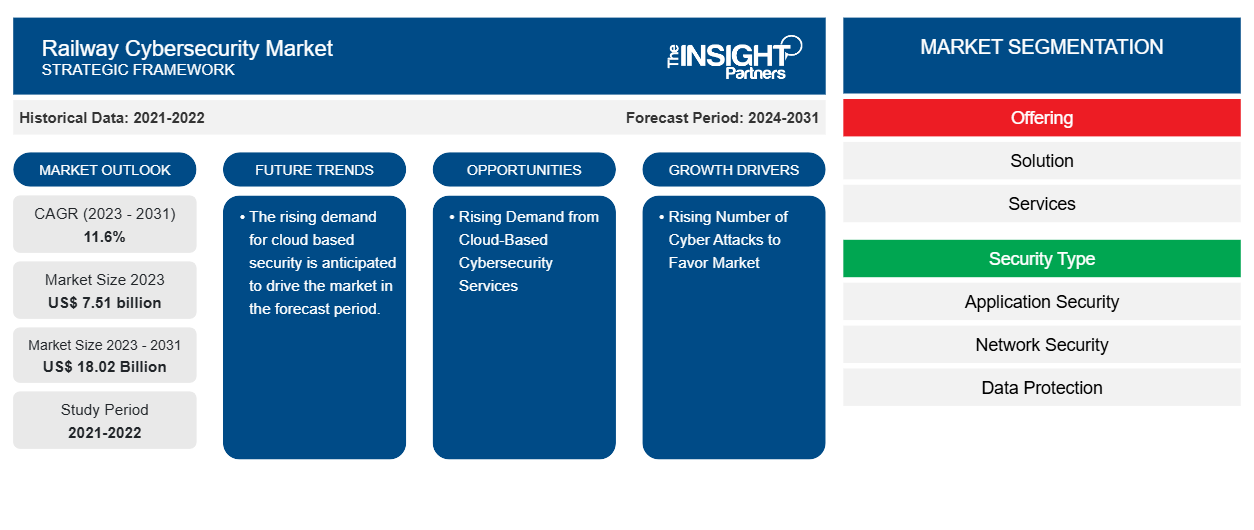Der Markt für Cybersicherheit im Schienenverkehr soll von 7,51 Milliarden US-Dollar im Jahr 2023 auf 18,02 Milliarden US-Dollar im Jahr 2031 anwachsen. Der Markt wird zwischen 2023 und 2031 voraussichtlich eine durchschnittliche jährliche Wachstumsrate von 11,6 % verzeichnen. Die steigende Zahl von Cyberangriffen und die zunehmende Einführung intelligenter Mobilitätslösungen im Schienenverkehr dürften die wichtigsten Treiber und Trends des Marktes sein.cybersecurity market size is projected to reach US$ 18.02 billion by 2031 from US$ 7.51 billion in 2023. The market is expected to register a CAGR of 11.6% during 2023–2031. The rising number of cyberattacks and growing adoption of smart mobility solutions in railways are likely to be the key drivers and trends of the market.
Marktanalyse für Cybersicherheit im SchienenverkehrCybersecurity Market Analysis
Der Markt für Cybersicherheit im Schienenverkehr verzeichnet weltweit ein erhebliches Wachstum. Dieses Wachstum ist auf die steigende Zahl von Cyberangriffen und die zunehmende Einführung intelligenter Mobilitätslösungen im Schienenverkehr zurückzuführen. Darüber hinaus werden die zunehmenden Gesetze und Vorschriften zur Cybersicherheit und die steigende Nachfrage nach Cloud-basierten Cybersicherheitsdiensten voraussichtlich das Wachstum des Marktes für Cybersicherheit im Schienenverkehr in den kommenden Jahren vorantreiben.
Marktübersicht zur Cybersicherheit im Schienenverkehr
Aufgrund der zunehmenden Abhängigkeit von digitalen Systemen und Technologien wird die Cybersicherheit bei Eisenbahnen immer wichtiger. Im Zuge der Modernisierung der Eisenbahnen wurden verschiedene computergestützte Systeme zur Überwachung und Steuerung des Betriebs eingeführt, von der Signalisierung und Gleisverwaltung bis hin zum Passagiermanagement und Fahrkartenverkauf. Diese Digitalisierung hat die Bahnsysteme für Passagiere und Betreiber komfortabler und effizienter gemacht.
Passen Sie diesen Bericht Ihren Anforderungen an
Sie erhalten kostenlos individuelle Anpassungen an jedem Bericht, einschließlich Teilen dieses Berichts oder einer Analyse auf Länderebene, eines Excel-Datenpakets sowie tolle Angebote und Rabatte für Start-ups und Universitäten.
-
Holen Sie sich die wichtigsten Markttrends aus diesem Bericht.Dieses KOSTENLOSE Beispiel umfasst eine Datenanalyse von Markttrends bis hin zu Schätzungen und Prognosen.
Treiber und Chancen auf dem Markt für Cybersicherheit im Schienenverkehr
Steigende Zahl von Cyberangriffen begünstigt den Markt
Kritische Infrastrukturen im Eisenbahnsektor sind zunehmend möglichen Cyberangriffen ausgesetzt. Konnektivität und der Einsatz von Technologie in allen Sektoren haben den Service für die Bürger verbessert, Prozesse und Ressourcen optimiert und die Qualität der Maßnahmen jedes Betreibers verbessert. Diese Konnektivität hat jedoch auch ihre Schattenseiten: Sie erleichtert böswilligen Akteuren die Aktionen, die den entsprechenden Dienst angreifen und stören können. Der Sektor ist mehreren Cyberbedrohungen ausgesetzt, die seinen Betrieb erheblich beeinträchtigen können. Zu den Hauptkomponenten, auf die Cyberangriffe abzielen könnten, gehören Kontroll- und Signalsysteme, Kommunikationsnetze und Verkehrsmanagementsysteme, Fahrgastinformations- und Ticketsysteme sowie Wartungs- und Asset-Management-Infrastrukturen.
Steigende Nachfrage nach Cloud-basierten Cybersicherheitsdiensten.Cybersecurity Services.
Die steigende Nachfrage nach Cloud-basierten Cybersicherheitsdiensten wird den Markt in den kommenden Jahren voraussichtlich antreiben. Cloud-basierte Cybersicherheitslösungen können bei der automatischen Verwaltung und Überwachung von Eisenbahnsignalsystemen helfen. Man kann den Status jedes Signals mithilfe von Sensoren verfolgen und die Einstellungen bei Bedarf automatisch ändern und anpassen. Dies kann zur Steigerung der Produktivität beitragen und Probleme verhindern, bevor sie auftreten. Ein Sensor erkennt beispielsweise sofort ein Problem mit einem bestimmten Signal. Und in der Cloud werden in Echtzeit Änderungen vorgenommen, die nur dieses Signal betreffen. Züge können diese Signale somit ohne Verzögerung oder Störungen vermeiden.cybersecurity services is anticipated to drive the market in the coming years. Cloud-based cybersecurity solutions can aid in the automatic management and monitoring of railway signalling systems. One can track the status of each signal using sensors and automatically change and modify settings as needed. It can assist in enhancing productivity and prevent problems before they occur. A
Segmentierungsanalyse des Marktberichts zur Cybersicherheit im SchienenverkehrCybersecurity Market Report Segmentation Analysis
Wichtige Segmente, die zur Ableitung der Marktanalyse für Cybersicherheit im Schienenverkehr beigetragen haben, sind Angebot, Sicherheitsart, Typ und Anwendung.cybersecurity market analysis are offering, security type, type, and application.
- Basierend auf dem Angebot ist der Markt für Cybersicherheit im Schienenverkehr in Lösungen (Risiko- und Compliance-Management, Verschlüsselung, Firewall, Antivirus/Antimalware, Intrusion Detection/Intrusion Prevention und andere) und Dienste unterteilt. Das Lösungssegment wird im Prognosezeitraum voraussichtlich einen erheblichen Marktanteil halten.cybersecurity market is divided into solutions (risk and compliance management, encryption, firewall, antivirus/antimalware, intrusion detection/intrusion prevention, and others) and services. The solution segment is anticipated to hold a significant market share in the forecast period.
- Basierend auf der Sicherheitsart ist der Markt für Cybersicherheit im Schienenverkehr in Anwendungssicherheit, Netzwerksicherheit, Datenschutz, Endpunktsicherheit und Systemadministration unterteilt. Das Segment Anwendungssicherheit wird im Prognosezeitraum voraussichtlich einen erheblichen Marktanteil halten.cybersecurity market is divided into application security, network security, data protection, endpoint security, and system administration. The application security segment is anticipated to hold a significant market share in the forecast period.
- Der Markt ist nach Typ in Betriebstechnologie (OT) und Informationstechnologie (IT) segmentiert. Es wird erwartet, dass das Segment Betriebstechnologie (OT) im Prognosezeitraum einen erheblichen Marktanteil halten wird.
Marktanteilsanalyse für Cybersicherheit im Schienenverkehr nach geografischer LageCybersecurity Market Share Analysis by Geography
Der geografische Umfang des Marktberichts zur Cybersicherheit im Schienenverkehr ist hauptsächlich in fünf Regionen unterteilt: Nordamerika, Asien-Pazifik, Europa, Naher Osten und Afrika sowie Süd- und Mittelamerika.cybersecurity market report is mainly divided into five regions: North America, Asia Pacific, Europe, Middle East & Africa, and South & Central America.
Nordamerika dominiert den Markt für Cybersicherheit im Schienenverkehr. Die Einführung von Hochtechnologie in verschiedenen Branchen in der nordamerikanischen Region hat das Wachstum des Marktes für Cybersicherheit im Schienenverkehr vorangetrieben. Faktoren wie die zunehmende Einführung digitaler Tools und hohe Technologieausgaben von Regierungsbehörden dürften das Wachstum des nordamerikanischen Marktes für Cybersicherheit im Schienenverkehr vorantreiben. Darüber hinaus zwingt eine starke Betonung von Forschung und Entwicklung in den entwickelten Volkswirtschaften der USA und Kanadas die nordamerikanischen Akteure dazu, technologisch fortschrittliche Lösungen auf den Markt zu bringen. Darüber hinaus gibt es in den USA eine große Anzahl von Akteuren auf dem Markt für Cybersicherheit im Schienenverkehr, die sich zunehmend auf die Entwicklung innovativer Lösungen konzentrieren. All diese Faktoren tragen zum Wachstum des Marktes für Cybersicherheit im Schienenverkehr in der Region bei.cybersecurity market. High technology adoption trends in various industries in the North American region have fuelled the growth of the railway cybersecurity market. Factors such as increased adoption of digital tools and high technological spending by government agencies are expected to drive the North American railway cybersecurity market growth. Moreover, a strong emphasis on research and development in the developed economies of the US and Canada is forcing the North American players to bring technologically advanced solutions into the market. In addition, the US has a large number of railway cybersecurity market players who have been increasingly focusing on developing innovative solutions. All these factors contribute to the region's growth of the railway cybersecurity market.
Regionale Einblicke in den Markt für Cybersicherheit im SchienenverkehrCybersecurity Market Regional Insights
Die regionalen Trends und Faktoren, die den Markt für Cybersicherheit im Schienenverkehr im Prognosezeitraum beeinflussen, wurden von den Analysten von Insight Partners ausführlich erläutert. In diesem Abschnitt werden auch die Marktsegmente und die Geografie des Marktes für Cybersicherheit im Schienenverkehr in Nordamerika, Europa, im asiatisch-pazifischen Raum, im Nahen Osten und Afrika sowie in Süd- und Mittelamerika erörtert.Cybersecurity Market throughout the forecast period have been thoroughly explained by the analysts at Insight Partners. This section also discusses Railway Cybersecurity Market segments and geography across North America, Europe, Asia Pacific, Middle East and Africa, and South and Central America.

- Erhalten Sie regionale Daten zum Markt für Cybersicherheit im Schienenverkehr
Umfang des Marktberichts zur Cybersicherheit im Schienenverkehr
| Berichtsattribut | Details |
|---|---|
| Marktgröße im Jahr 2023 | 7,51 Milliarden US-Dollar |
| Marktgröße bis 2031 | 18,02 Milliarden US-Dollar |
| Globale CAGR (2023 - 2031) | 11,6 % |
| Historische Daten | 2021-2022 |
| Prognosezeitraum | 2024–2031 |
| Abgedeckte Segmente |
Durch das Angebot
|
| Abgedeckte Regionen und Länder |
Nordamerika
|
| Marktführer und wichtige Unternehmensprofile |
|
Dichte der Akteure auf dem Markt für Cybersicherheit im Schienenverkehr: Die Auswirkungen auf die Geschäftsdynamik verstehen
Der Markt für Cybersicherheit im Schienenverkehr wächst rasant. Dies wird durch die steigende Nachfrage der Endnutzer aufgrund von Faktoren wie sich entwickelnden Verbraucherpräferenzen, technologischen Fortschritten und einem größeren Bewusstsein für die Vorteile des Produkts vorangetrieben. Mit der steigenden Nachfrage erweitern Unternehmen ihr Angebot, entwickeln Innovationen, um die Bedürfnisse der Verbraucher zu erfüllen, und nutzen neue Trends, was das Marktwachstum weiter ankurbelt.
Die Marktteilnehmerdichte bezieht sich auf die Verteilung von Firmen oder Unternehmen, die in einem bestimmten Markt oder einer bestimmten Branche tätig sind. Sie gibt an, wie viele Wettbewerber (Marktteilnehmer) in einem bestimmten Marktraum im Verhältnis zu seiner Größe oder seinem gesamten Marktwert präsent sind.
Die wichtigsten auf dem Markt für Cybersicherheit im Schienenverkehr tätigen Unternehmen sind:
- CAPGEMINI SE
- Cisco Systems, Inc.
- Collins Luft- und Raumfahrt
- Hitachi, Ltd.
- Huawei Technologies Co.
- GmbH.
Haftungsausschluss : Die oben aufgeführten Unternehmen sind nicht in einer bestimmten Reihenfolge aufgeführt.

- Überblick über die wichtigsten Akteure auf dem Markt für Cybersicherheit im Schienenverkehr
Nachrichten und aktuelle Entwicklungen zum Cybersicherheitsmarkt im Schienenverkehr
Der Markt für Cybersicherheit im Schienenverkehr wird durch die Erhebung qualitativer und quantitativer Daten nach Primär- und Sekundärforschung bewertet, die wichtige Unternehmensveröffentlichungen, Verbandsdaten und Datenbanken umfasst. Nachfolgend sind einige der Entwicklungen auf dem Markt für Cybersicherheit im Schienenverkehr aufgeführt:
- Cylus, ein renommierter Marktführer im Bereich Cybersicherheitslösungen für den Schienenverkehr, gab einen Erfolg bekannt: Seine Vorzeigelösung CylusOne hat den begehrten Titel als weltweit erste Cybersicherheitslösung für den Schienenverkehr erhalten, die die prestigeträchtige IEC 62443-4-2-Zertifizierung für Sicherheitsstufe 3 erhalten hat. (Quelle: Cylus Company Website, Februar 2024)
- Strides International Business wird mit Egis eine Absichtserklärung (MoU) zur Bereitstellung von Cybersicherheitsdiensten im Eisenbahnsektor unterzeichnen. (Quelle: Strides International Business Company Website, November 2023)
Marktbericht zur Cybersicherheit im Schienenverkehr – Umfang und Ergebnisse
Der Bericht „Marktgröße und Prognose für Cybersicherheit im Schienenverkehr (2021–2031)“ bietet eine detaillierte Analyse des Marktes, die die folgenden Bereiche abdeckt:
- Marktgröße und Prognose für Cybersicherheit im Schienenverkehr auf globaler, regionaler und Länderebene für alle wichtigen Marktsegmente, die im Rahmen des Berichts abgedeckt sind
- Markttrends und Marktdynamiken im Bereich Cybersicherheit im Schienenverkehr, wie Treiber, Einschränkungen und wichtige Chancen
- Detaillierte PEST/Porters Five Forces- und SWOT-Analyse
- Analyse des Cybersicherheitsmarktes im Schienenverkehr, die wichtige Markttrends, globale und regionale Rahmenbedingungen, wichtige Akteure, Vorschriften und aktuelle Marktentwicklungen umfasst
- Branchenlandschaft und Wettbewerbsanalyse, einschließlich Marktkonzentration, Heatmap-Analyse, prominenten Akteuren und aktuellen Entwicklungen für den Markt für Cybersicherheit im Schienenverkehr
- Detaillierte Firmenprofile
- Historische Analyse (2 Jahre), Basisjahr, Prognose (7 Jahre) mit CAGR
- PEST- und SWOT-Analyse
- Marktgröße Wert/Volumen – Global, Regional, Land
- Branchen- und Wettbewerbslandschaft
- Excel-Datensatz
Aktuelle Berichte
Verwandte Berichte
Erfahrungsberichte
Grund zum Kauf
- Fundierte Entscheidungsfindung
- Marktdynamik verstehen
- Wettbewerbsanalyse
- Kundeneinblicke
- Marktprognosen
- Risikominimierung
- Strategische Planung
- Investitionsbegründung
- Identifizierung neuer Märkte
- Verbesserung von Marketingstrategien
- Steigerung der Betriebseffizienz
- Anpassung an regulatorische Trends























 Kostenlose Probe anfordern für - Markt für Cybersicherheit im Schienenverkehr
Kostenlose Probe anfordern für - Markt für Cybersicherheit im Schienenverkehr